California Zephyr and Cinerama Holiday |
Read more at in70mm.com The 70mm Newsletter |
| Written by: Frank Brehm, Western Pacific Railroad History Online web site | Date: 13.03.2016 |
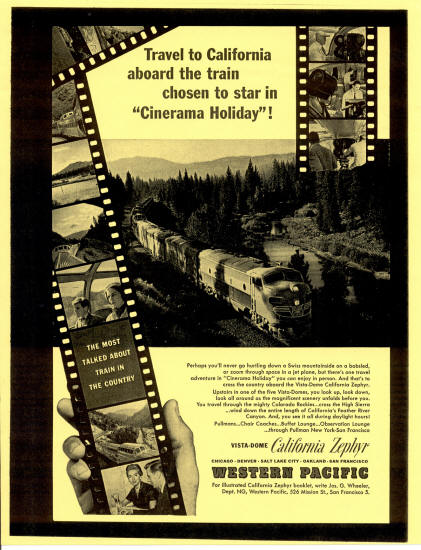 Since
its debut the California Zephyr had included among its ridership well known
actors and actresses, state and federal political figures, foreign heads of
state, as well as many others then in the public eye. Since
its debut the California Zephyr had included among its ridership well known
actors and actresses, state and federal political figures, foreign heads of
state, as well as many others then in the public eye.One of those early riders happened to be Louis de Rochemont, a prominent and successful New York motion picture producer, who proclaimed it "the finest train I have ever ridden." Because of his fond memory of that ride on the Zephyr Mr. de Rochemont invited the three railroads operating the transcontinental streamliner, Western Pacific, Denver & Rio Grande and the Chicago, Burlington & Quincy to take part in his production of the second Cinerama film—"Cinerama Holiday." Mr. de Rochement was not new to motion pictures. A former line officer in the U. S. Navy, he was formerly a staffer for International Newsreel, assistant editor of Pathe News, director and producer of Twentieth Century-Fox, and co-founder and first producer of "The March of Time." He produced such pictures as "The Ramparts We Watch," "The Fighting Lady," "The House on 92nd Street," "13 Rue Madeline," "Lost Boundaries" which received eleven major awards, and others. The first feature film "This Is Cinerama," premiered on the evening of September 30, 1952 at the Broadway Theatre in New York City. The second film, Louis de Rochemont's "Cinerama Holiday" marking a big advance in the use of the Cinerama process had its premiere on February 8, 1955 at the New York Warner Theatre. Where the first Cinerama production was intended as a demonstration of the new medium, which it was believed would revolutionize the motion picture industry, "Cinerama Holiday" was a story-telling picture. The theme of "Cinerama Holiday" concerns the travel adventures of two young couples, an American couple touring Europe and a European couple seeing America. Two Cinerama units were used simultaneously to film the experiences of the American couple in Europe while the American scenes were being taken. |
More in 70mm reading: Betty York, A Mini Bio Cinerama, David Strohmaier and the "We have all seen it as a kid" thing Flicker Alley presents "CINERAMA HOLIDAY" in70mm.com's Cinerama page Cinerama Remaster Internet link: Western Pacific Railroad History Online |
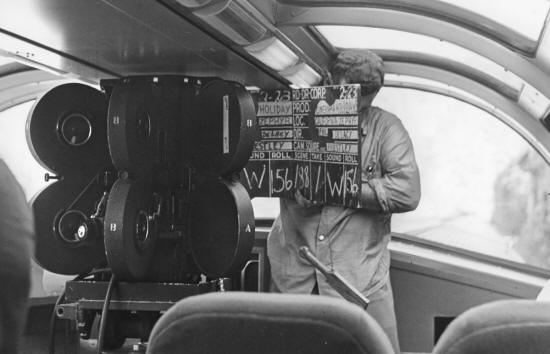 Filming
of "Cinerama Holiday" in the Vistadome car. Note 3-panel camera and 3-panel
slate. Filming
of "Cinerama Holiday" in the Vistadome car. Note 3-panel camera and 3-panel
slate.Neither of the Europeans, a young Swiss artist named Fred Troller and his charming wife, Beatrice, is a professional. They were selected for their parts by de Rochemont for realism as a happy sightseeing couple actually on their first trip to America. Their itinerary included a trip around the East, a ride through the Arizona Indian country via motor scooter, and after a week spent in San Francisco, returns to Chicago aboard the California Zephyr. The picture ends when the four young people meet after their travels to compare their exciting experiences. In order to film the sequences aboard the California Zephyr an extra vista-dome streamliner was run clear through from Oakland to Chicago. With the cooperation and coordination of the three railroads a special train schedule had been fixed six weeks prior to the start of production with that of the regularly scheduled trains. The special left Western Pacific's Oakland yard on February 22, 1954. Aboard the train, in addition to the Trollers, were Otis Carney, the writer and producer in charge of this Cinerama unit; Philippe de Lacy, the director; cameraman Harry Squires, ASC, who filmed "This Is Cinerama" and aided in development of the special camera; the Cinerama crew of some 30 people; some Western Pacific employees and the usual train and Pullman personnel including the Zephyrette. The Cinerama support trucks were routed separately to meet the train each evening. |
|
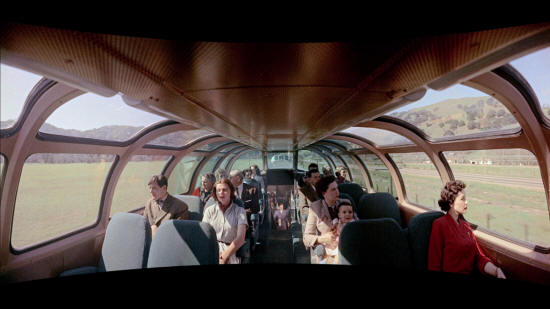 Frame
blow up from remastered "Cinerama Holiday".
Note the Trollers to the left. Frame
blow up from remastered "Cinerama Holiday".
Note the Trollers to the left.Click the image to see enlargement Three months of advance preparation was done to prepare the special train for its part in the picture. The normal glare-proof safety glass was removed from one of the vista domes and replaced with thin sheets of optically perfect plexiglass in order to insure technically perfect filming of the scenery without the least color distortion or reflection. (The normal vista-domes slightly tinted safety glass had little effect on color pictures taken by non - professional photographers.) The first three pairs of seats on each side of one dome were removed to allow room for setting the camera when shooting exteriors from the dome, or interiors of the passengers within. Special platforms were added to enable the camera to work inside and outside of the train. Also, in order to take action pictures of on-coming trains and achieve the realistic feeling of being on a speeding train, the door was removed from the front of the diesel cab and replaced with a specially made plywood panel equipped with a small hole to accommodate the triple lenses of the camera and a viewing window for the cameraman. Cars used in the special included a baggage car, diner, two sleepers, vista-dome coach and lounge observation car from regular California Zephyr equipment, a standard sleeper, and a Western Pacific business car. The train was hauled by a three-unit passenger diesel set. The baggage car was used for the generators supplying power for the camera and lights cabled throughout the entire train, baggage of those aboard the train, the motor scooter, and other necessary equipment. Panel trucks, some equipped with darkroom facilities, camera repair facilities, extra generators and other equipment not used for train sequence shots were loaded in gondolas and sent on ahead by freight train. Telephone equipment was installed throughout the train in order to communicate with the engine crew when necessary to back up and re-shoot pictures. |
|
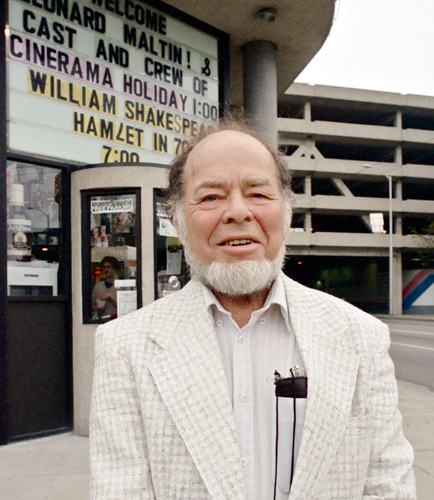 Director
of "Cinerama Holiday", Louis de Rochemont III. Picture by Thomas Hauerslev Director
of "Cinerama Holiday", Louis de Rochemont III. Picture by Thomas HauerslevActual filming of the railroad part of the picture began on February 21, 1954 under the direction of Louis de Rochemont III, Mr. de Rochemont’s son, when exterior shots were made of the California Zephyr leaving Oakland. Before the special left Oakland the following day, the camera was placed in the nose of the diesel for shots moving through C. T. C. signals and downtown Oakland en route to Niles. A stop was made at Niles to transfer the camera from the diesel into the dome car for pictures in Niles Canyon, after which the special proceeded to Oroville where it tied up for the night. The director and camera crew then proceeded by track motor car with John McNally, assistant superintendent, for an inspection trip of the Feather River Canyon as far as Pulga to plan the next day's shooting. The next morning the train left Oroville for Pulga where pictures were taken from the dome of the meet with the westbound California Zephyr. The special was then backed to Bloomer to continue the day's shooting while traveling through the Feather River Canyon as planned on the previous day. During the course of the day the 300-pound, $250,000 camera was shifted several times between the dome and the diesel, all of which required meticulous handling and considerable time. A short stop was made at Portola. While the cast enjoyed a snowball fight the camera crew proceeded to set up the camera and huge Kleig lights in the rear lounge car for shots that evening as the train proceeded on to Salt Lake City at normal speed. The realism of Cinerama is such that those who view the picture have all the sensations of being right at the scene of action. The three-lens camera covers an angle of 146 degrees and gives the feeling of seeing straight ahead as well as to both sides, very nearly the same as normal vision. Sounds are also completely realistic, being reproduced on seven sound tracks and heard from whatever direction the action is taking place on the screen. |
|
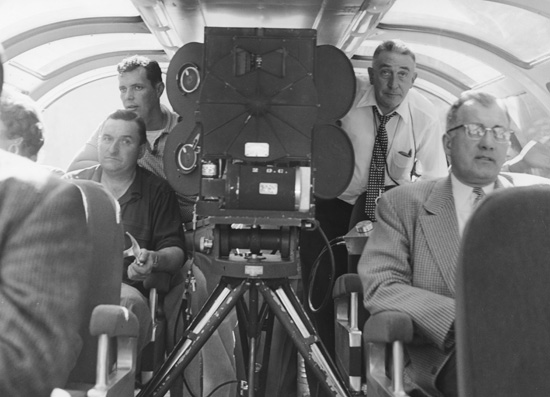 Filming
of "Cinerama Holiday" in the Vistadome car. Filming
of "Cinerama Holiday" in the Vistadome car. With Cinerama you actually perceive more than you would if you were on the scene, strange as that may seem. This is the new technique for seeing the world of reality as well as the world of make-believe through new eyes. In addition to the Trollers and the train personnel, Western Pacific personnel taking part in the picture were Barbara Gunzel, Fran Skinner, Marilyn Craig, Bonnie Barnhill, Claire Postel and her husband, "Bee," a former employee, Arthur Lloyd and his wife, Eleanor, Mrs. Dan Irwin and her daughter, Cheryl Anne, Mr. and Mrs. Joseph G. Wheeler, James J. Hickey, and Gilbert H. Kneiss. It was thanks to this newest advance in movie production that millions of people who had never had a chance to ride the California Zephyr now had that opportunity when they saw "Cinerama Holiday." This second Cinerama presentation had its San Francisco premiere at the Orpheum Theater on August 2, 1955 and was also being shown in Chicago, Dallas, Detroit, Minneapolis, Philadelphia, Pittsburgh and St. Louis. It was also to be shown in Los Angeles and Washington, D. C., and in several European countries. At the time of the “Cinerama Holiday” premier there were 19 theatres worldwide which had been equipped to show this complete illusion of three dimensional effects in color and sound without the use of glasses. The complete illusion of three-dimensional effects in color and sound gives movie-goers a thrilling sensation, second only to actually riding on the train. Not only does the viewer experience the feeling of really riding in a Vista-dome as the train passes through the colorful Feather River Canyon, but through the three eyes of the Cinerama camera he experiences other sensations not commonly available to passengers on the train. From the very front of the diesel cab the roadbed literally leaps at the viewer while the train winds its way along the brink of the Canyon. Then, from a platform built out from the side of the train, the camera brings to the screen another unexperienced thrill as the California Zephyr sweeps around the curves. |
|
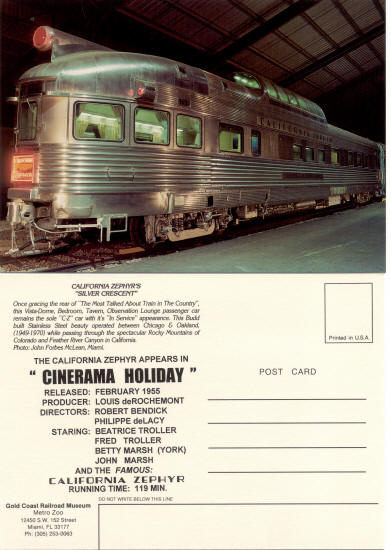 The
Marsh’s, accompanied by Mr. and Mrs. de Rochemont, experienced part of the
journey enjoyed by the Troller’s during filming of the picture, when they
rode to San Francisco aboard the California Zephyr to take part in the
premiere at San Francisco. The
Marsh’s, accompanied by Mr. and Mrs. de Rochemont, experienced part of the
journey enjoyed by the Troller’s during filming of the picture, when they
rode to San Francisco aboard the California Zephyr to take part in the
premiere at San Francisco.Upon arrival in Oakland they were greeted by Western Pacific President Fredrick Whitman, a host of dignitaries, and press, radio and television writers, followed by a cocktail party held aboard the California Zephyr's diner as it was being transferred to WP's coach yard for servicing before its return trip to Chicago. Prior to the premiere, the "Cinerama Holiday" party attended a dinner at the Palace Hotel where they were entertained by Western Pacific's choral group. They then took part in a parade up Market Street from the hotel to the Orpheum Theater. After its premiere in New York on February 8, 1955, "Cinerama Holiday" went on to become the second highest grossing film of 1955 in the United States and continued being shown in Cinerama equipped theaters through 1962. In spite of their popularity with 1950s film audiences, the Cinerama films became largely forgotten for many years as none were released on home video in which to remind modern audiences of the reasons that these films were so popular in their day. The Cinerama process though has never really been forgotten as there have been various film festivals over the years in which these films have been highlighted. One of those film festivals occurred in Dayton, Ohio over the weekend of April 26 & 27, 1997. This would be the first time since the release of the original film that the Marsh’s and the Troller’s had seen each other. This allowed "in person" appearances by the 2 couples for those in attendance. During the intermission, another rare treat was when the breakdown/emergency reel that was made for "Cinerama Holiday" by the two couples, but which none of them had ever seen, was shown. It was during this showing that the age of the film became apparent as the print had lost the majority of yellow and blue, so was quite pink. It is through the efforts of David Strohmaier and Cinerama in restoring this classic treasure and preserving it for the ages that it is now available on Blu-ray disk. Flicker Alley in 2013 released the restored version, including color, of "Cinerama Holiday". |
|
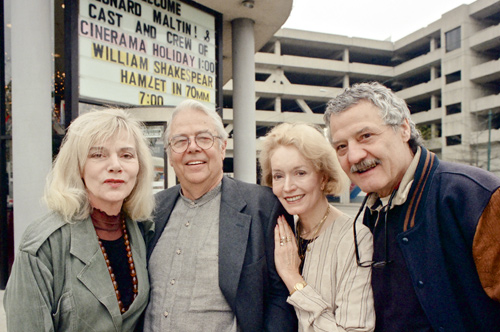 The
Trollers and the Marshes, outside the New Neon in Dayton Ohio. USA. Left to
right: Beatrice Troller, John Marsh, Betty Marsh York and Fred Troller. Picture by Thomas Hauerslev The
Trollers and the Marshes, outside the New Neon in Dayton Ohio. USA. Left to
right: Beatrice Troller, John Marsh, Betty Marsh York and Fred Troller. Picture by Thomas HauerslevThomas Hauerslev, who has the www.in70mm.com web site, from which some of the photos and information came from has been in contact with Betty and after seeing the original text for this page sent Thomas a mini-bio which he forwarded to me with the comment, “Betty felt a little left out of the story, so she sent me her mini-bio"; Sometime after Cinerama Holiday John and Betty Marsh divorced, both eventually remarried. John built up a successful dental practice in Overland Park, Kansas. John was known as a great dentist who also had a love of the outdoors and was an avid hunter. John was killed in an automobile accident in Harrisonville, Missouri on September 25, 1998. He was 71 years old at the time of his death. Fred Troller became a well known design director who helped popularize a minimalist typographic style called Swiss New Typography in the United States in the 1960's. An alternative to the decorative and ornamental graphic-design mannerisms fashionable in the 60's, the Swiss approach relied on stark photographic imagery, bold sans-serif typefaces and primary colors in unfettered compositions. Fred specialized in trademarks, advertisements, annual reports and book jackets for clients like Exxon, General Electric, I.B.M., Westinghouse and Doubleday. It was in the 1970's that he created a series of eye-catching destination posters for American Airlines that were more like stop signs than scenic tableaus. Fred died on October 11, 2002 at his home in Rye, New York of cancer. He was also 71 at the time of his death. Beatrice, who moved with Fred to the United States in the early 1960s, studied photography at New York University and became a noted photographer with her expressive and experimental personal photography having her work displayed in exhibits at the Swiss Institute of New York, the Hiram Halle Memorial Library in Pound Ridge, New York; the Swiss Institute in New York, the Rye Arts Center Gallery, the Wainwright House in Rye, New York; and the Parrish Art Museum in Southhampton, New York. Beatrice passed away on August 18, 2015 after a valiant battle with cancer at the age of 83. I want to thank Thomas Hauerslev for his assistance and permission to use his photos here. If you are interested in large film format movies I recommend visiting his site www.in70mm.com |
|
| Go: back - top - back issues - news index Updated 21-01-24 |
